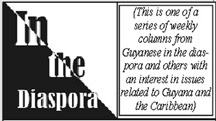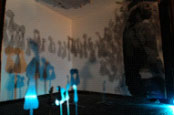Sandra Brewster is a Toronto based visual artist and community arts practitioner. For information on her work go to www.sandrabrewster.com.
By Sandra Brewster
I grew up hearing stories of various family members’ participation in the Theatre Guild in Guyana, and suspected that the urgency of making a life for themselves after the move to Toronto limited their ability to further pursue the arts. However, my mother and her friends – over 40 years ago – began what is now called the Senior Guyanese Friendship Association which has a strong creative component to which I’ve always been exposed. And my mom and dad expressed their creativity in many ways – mom in her craft making, gardening and cooking, and dad dabbled with and played the piano, guitar and harmonica. He also believed he was a wonderful singer. Dad passed away in ‘96 and once in a while I pop in a tape of he and I, at 4 years old, singing Inch Worm just to hear his voice. Both my parents had drawing talent as well. When I was five my father’s cousin, Errol, himself a visual artist, came to live with us in Toronto while attending Ontario College of Art. He was always present in my mind. Although I hadn’t been in contact with him until around 2008 my mom would tell stories of him picking my hair out into a big afro and sitting me in the centre of his friends while they engaged in intense political debate. We owned 2 drawings of his that apparently my mother rescued from the trash bin. I had them framed.


In my art work I am concerned with themes of identity, representation and memory and focus on people from the Caribbean who arrived in North America in the 1960s and 70s. In my early work I referenced old photographs from family albums to create drawings that suggest a particular time or feeling. I did this by enlarging specific areas of the image, usually a portrait. Collectively, these drawings suggest a similarity between each other and a connection to, or style of, back home regardless of the location of the person in the piece. My Stance series is made of charcoal drawings comprised of close cropped – neck to waist – portraits referencing old photographs gathered from family and friends to express the style of clothing and posing in common.
In series like Cool, Cool Pose, Stance and Profile, as well as other works, I continued to explore the portrait and the demeanours of people in them. The work was always aligned with discussions around identity which later influenced the works called Smith. Beginning playfully, the Smiths were created to mock the notion of monolithic racialized communities. Represented as simply rendered characters that don afros, they carry bodies shaped like a blob. The area of the face is collaged with photo transfers of pages of the phone directory. In some pieces I’ve used the Smiths to explore gun violence among and towards young people. They are represented as community members who are witness to, playing a part in or reacting to a scene of violence. Supporting this theme, I recently created a triptych for an exhibition in Pennsylvania. Entitled Gathered and in Procession, the Smiths, finely drawn and lightly painted in white, appear as in a procession traveling across each of the 3 sheets of paper. Paint is applied in thick layers on the background and the brushstrokes gradually increase in aggressiveness, the colour changing from a neutral grey to a dark red.
In February, 2013 I carried the Smiths to Trinidad where I enjoyed allowing them to be influenced by the island. During a residency at Alice Yard in Port of Spain I renamed the Smiths, Mohammeds and created drawings and sketches on various surfaces in the Yard. My final presentation included 60 aluminum structures, shaped as various silhouettes of my characters, 2 feet high from the ground, and situated throughout the Yard to suggest a Carnival procession. They led the way to a mural of Mohammeds travelling across the Yard’s gallery wall, then wrapping around a large scale photo transfer of a woman in a bikini costume.
While playing mas with Cat in Bag Productions that year – a camp of fun as well as social and political awareness – I was exposed to discussions of the history of carnival and the importance of performance and artistry in the development of mas. The piece I created at Alice Yard was my interpretation of the apparent tensions between the appreciation for the creativity of mas and the commercialization and profit driven entity of what much of it has become.
In 2008 I finally traveled to Guyana for the first time. My aunt’s friend invited her. I joined them. The trip fulfilled my dream to see, visit or at least be close to the places I heard about all my life. Streets like Camp Street, Middle Street, and High Street; villages like Kingalee, Bran, Phoenix and Ross, the wooden built Saint George’s Cathedral, Stabroek Market and Castellani House, Bookers and Fogarty’s, my aunts’ schools – Bishops, Central High, St. Roses. I stood at the top of Kaieteur Falls and went speed boating in the Essequibo. I was part of endless conversations that exposed my ignorance around topics concerning Guyana and its history. Of course I felt like, and was seen as a foreigner.
However, at the same time, I felt a familiarity with Guyana, using other people’s memories as reference. I took advantage of those memories. I visited my Grandmother’s childhood home in the village. It was still there. Although another house was built in its place, I saw where my mom and her brothers and sisters grew up. And I made sure I wrapped up sapodilla and wiri wiri peppers in my luggage to bring home. I had heard the nostalgic stories of beautiful Georgetown over and over again and tried to imagine what it looked like and felt like so many years before. I truly could not believe I was actually “back home”.
One day, in Georgetown, I was observing a line up of young girls in their school uniforms, and found myself pondering what it would have been like to grow up there. Upon my return to Toronto I created paintings called Guyana Girl that included images of these children alongside a drawing of my cousin wearing her high school kilt in one, my sister swinging in a playground in another.
My interest in community, the gathering of people and the need to make apparent what may be deemed invisible led me to begin Open House. I live in the west end of Toronto. Many artists live in this area and many galleries have moved into it, escaping the high rental costs in peak areas of the city. When I first moved here I noticed a push to enhance the neighbourhoods through art. Exhibitions and projects started popping up especially to celebrate the artists of the area. After attending these events a few times and only knowing one artist I decided to start up an event in my home that displayed the works of artists who I knew lived in my area.
Open House started with 14 exhibiting artists with opportunities to engage with each other. The group was culturally diverse with the majority being of Caribbean background. My sister (who lives with me) and I welcomed approximately 250 people into our home for the opening reception of the first year. Art goers of all types came through and very quickly this event grew in popularity and numbers. Last year was the third year. 26 artists exhibited their work and we welcomed over 450 attendees. Always about the people present and their engagement with the city and each other, Open House was more than an art exhibition.
Like most of my other work, Open House was probably influenced by family stories. I have nine aunts and uncles on my mother’s side and was told there were neighbours and family members who would pass through their home in Georgetown. People were always welcome, some dropped by unexpectedly, and my Grandmother would feed all of them no matter how much food was in the pot.




